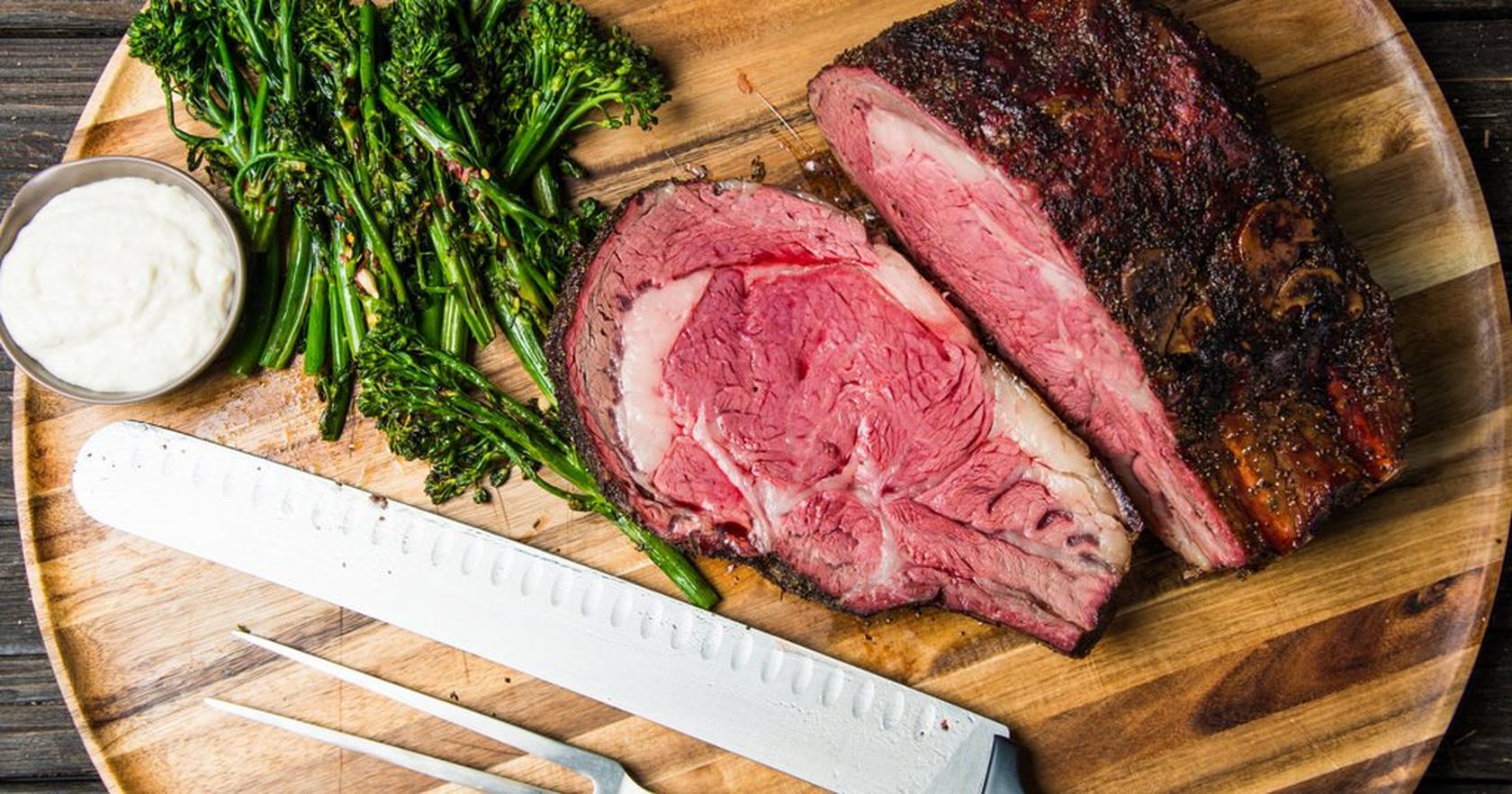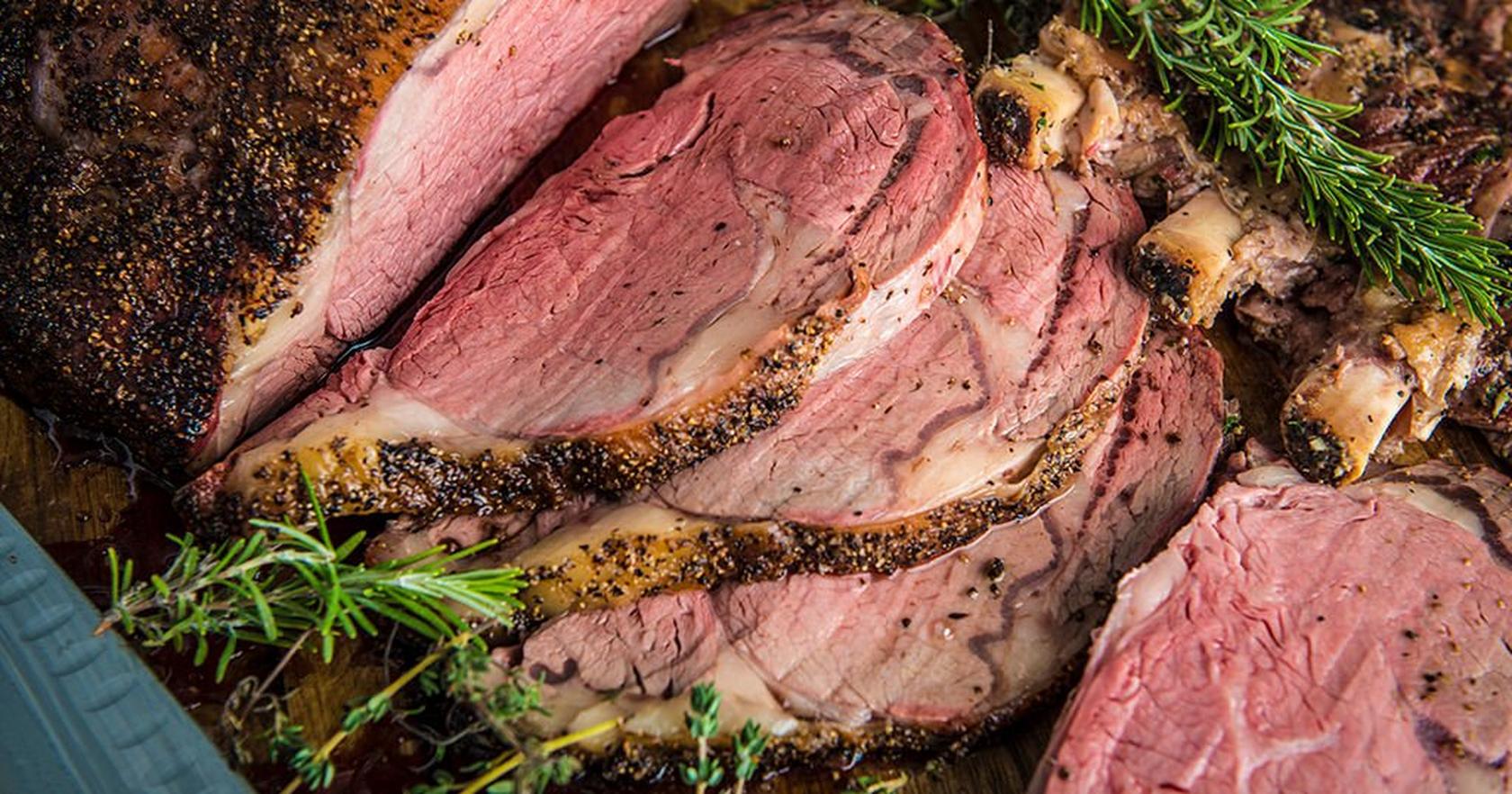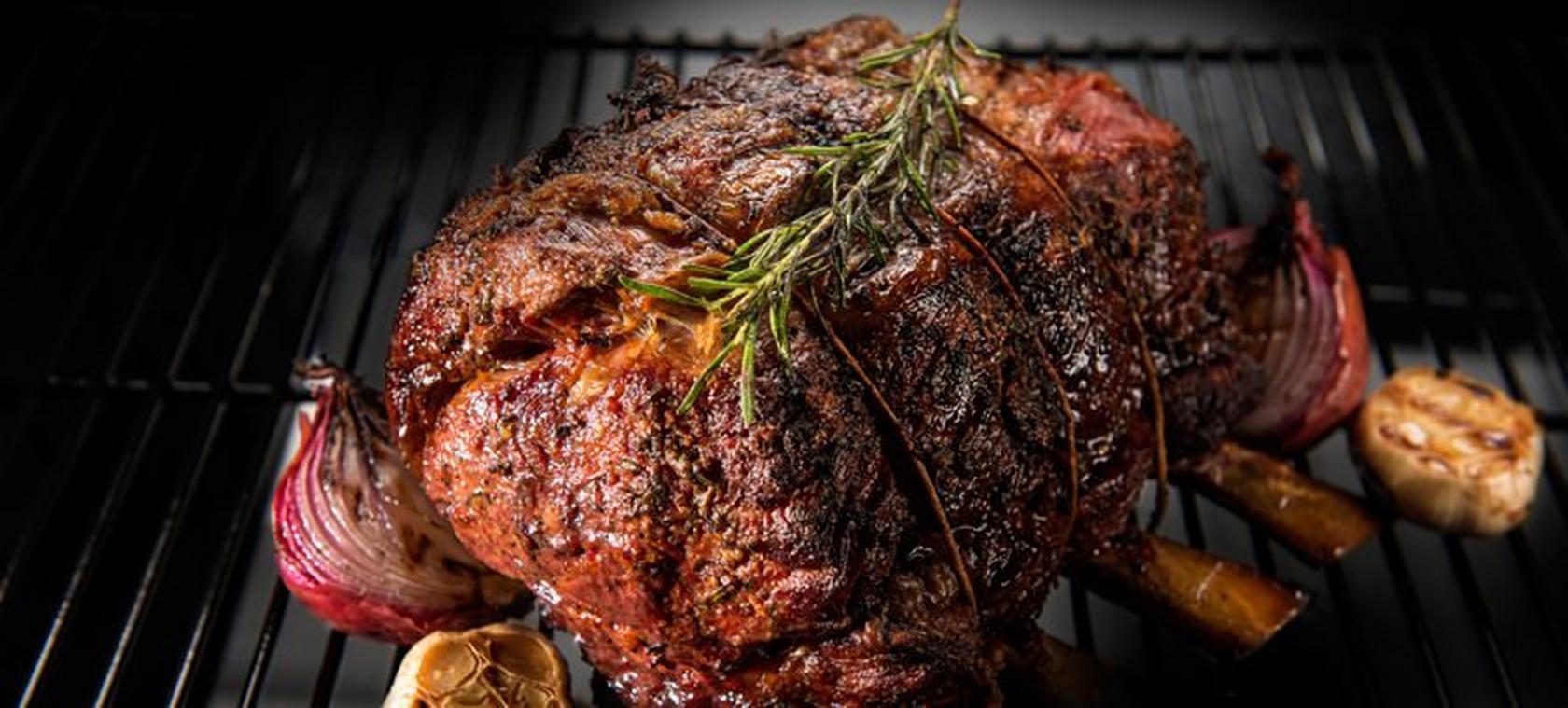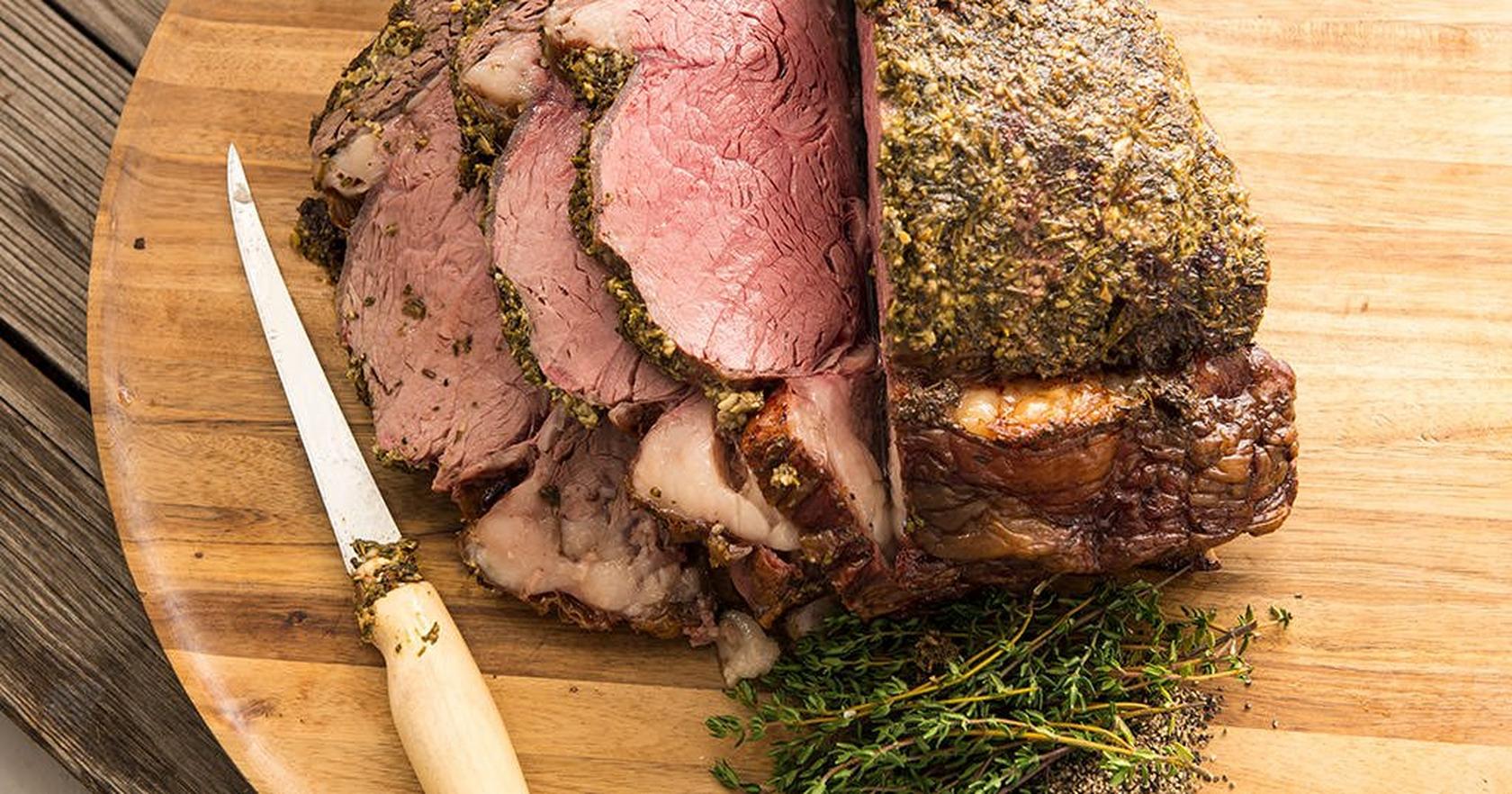
Prime rib is one of the most delicious cuts of meat, perfect for special occasions, and cooking it doesn't require any special skills. However, it can be pricey, so you want to be sure it turns out right. To nail it, understanding prime rib cooking times is key, especially when using your Traeger pellet grill to achieve perfect results.
There are different approaches to cooking this large cut of meat. Some prime rib recipes start on high heat then finish lower, some cook at one steady temperature, while others start low then finish high. No matter your approach, the Traeger prime rib method locks in flavor and delivers that signature wood-fired finish.
What is Prime Rib?
Asking yourself what is prime rib? Prime rib is a large meat cut that includes the 6th to 12th ribs of a steer. The cut is often sold in sections of 2 to 4 ribs: ribs 6 to 9 (which is usually the fattier cut) or ribs 10 to 12 (which typically has leaner meat).
Prime Rib Cuts
There’s more to prime rib than might meat the eye, including the different meat cuts to choose from:
- First Cut (AKA the "Loin End" or "Small End"): This cut comes from the back of the rib primal and boasts the most tenderness. It’s leaner, with less marbling, making it a great choice for those who prefer a milder flavor and buttery texture.
- Second Cut (AKA the "Chuck End" or "Large End"): Packed with marbling, this cut comes from the front of the rib primal. It’s rich, beefy, and perfect for those who want bold flavor and don’t mind a bit of extra fat. Think melt-in-your-mouth indulgence with every bite.
- Bone-In Prime Rib (AKA, the “Standing Rib Roast”): For the ultimate wow factor, go bone-in. The bones act as a natural heat shield, locking in moisture while adding incredible flavor. Plus, who doesn’t love gnawing on a juicy bone after the feast
- Boneless Prime Rib: Want ease of carving? Go boneless. While it lacks the bone’s flavor-boosting power, it’s still a showstopper on the grill and ideal for slicing into picture-perfect steaks.
Bone-in or Boneless Prime Rib?

You can order prime rib as bone-in or boneless.
A boneless prime rib roast is easier to form into a round shape and are also easier to carve.
A bone-in roast has advantages, too. For one, you get the bones -- which you can remove to make soup or a sauce or leave in for people (but not pets!) to nibble. With the bones left in, the temperature throughout the prime rib on the pellet grill tends to stay more even.
One way to get the best of both worlds is to cut off the rib plate before cooking the Traeger prime rib recipe and then tie it back on. Post-cook, you can easily remove the bones for slicing but still get those tasty treats.
Where to Buy Prime Rib
Buy the best prime rib from your local specialty butcher or full-service supermarket butcher. In nearly all cases, you'll have to call ahead to order.
Very few supermarkets carry prime rib on a daily basis like they do with chicken thighs or sirloin steak. (The exception is during the winter holiday season.) You'll probably have to pre-order your prime rib. Pre-ordering your prime rib gives you complete control over what you end up getting.
Our recommendations:
- Order a fresh prime rib, not frozen.
- Order as far in advance as you can, and take delivery at least three days before you plan to serve it, for preparation purposes.
- If you don’t want to remove it yourself, ask for the butcher to remove the chine bone.
- Ask for USDA top choice grade or better. Specify the size you want, planning on 1/2 to 1 pound per person.
- Specify bone-in or bone removed.
How Much Prime Rib Per Person
One pound of prime rib (before cooking) per person is a good estimate if you want to be safe and/or have leftovers. But, if there is a first course and plenty of sides, you can usually get away with 1/2 pound per person.
How Long To Cook a Prime Rib
When it comes to cooking prime rib, you want to cook it to the desired internal temperature. How long that might take depends on a lot of variables including the size of the roast, the temperature of the grill, and even the weather.
Prime Rib Cooking Time Per Pound
A good general guideline for smoking prime rib on the Traeger is about 20 minutes per pound at 275°F for rare, but remember, every roast is unique. For precision, use an internal meat thermometer to monitor the internal temperature and ensure your prime rib hits that perfect level of doneness.
Best Prime Rib Internal Temperature
The best internal temperature for smoked prime rib is 130°F for medium-rare.
Take a look at our grilling gifts guide and pick out a good internal meat thermometer to get the best results (and some other goodies).
How to Prep Prime Rib for Cooking
Prime rib preparation can be as simple as sprinkling on some salt and pepper before roasting.
Trim Excess Fat From Prime Rib
You want some fat on your prime rib. It's a protective layer that helps keep the meat moist. But excess fat could alter the cooking time and limit the amount of smoke flavor you get. We recommend you trim away any fat that is over an inch thick but don't trim fat down to less than a quarter-inch thick.
Ideally, your butcher will do this before it comes to you.
Optional: Frenching the Roast
A frenched roast has the meat cut away from the bones, leaving the bones exposed for a dramatic presentation. This is a purely aesthetic choice, as frenching won't materially affect how the roast tastes or cooks. You can often buy the roast Frenched by the butcher. The downside is you lose the bits of fat and meat from the bone, which many people like to eat.
Dry Brine for Prime Rib
Experienced pitmasters recommend starting your prime rib preparation days in advance with a dry brine. That's a BBQ term for salting your meat, then letting it sit in a refrigerator while the salt penetrates the meat. A dry brine for a thin pork chop might only take an hour but because prime rib is such a thick cut of meat, the salt needs time to work its way from the surface of the cut to the center. If you choose to do a dry brine, salt the meat 24 to 48 hours before you plan to cook, and leave it in your refrigerator until an hour before cooking.
How to Shape the Roast
Your prime rib will cook more evenly if it is formed into a circular, cylindrical shape.

Think of cooking a chicken breast. Often the thinner edge gets cooked harder than the bulbous middle. This doesn't matter so much for chicken because we're only talking about a few extra minutes of cooking. With prime rib, which cooks for a much longer time, you could end up with a whole section of meat that reaches the target temperature 45 minutes before the center of the roast does. That whole section could end up being unpleasantly tough.
You can shape your prime rib with kitchen twine. Wrap the twine tightly around the roast so the long end is circular.
How to Smoke a Prime Rib on a Pellet Grill

Cooking a prime rib in a pellet smoker is the best way to do it. The heat will circulate evenly around the roast, giving the skin a pleasing exterior, while the fat inside slowly melts and distributes throughout the roast. Here's one method:
- Set Traeger temperature to 250°F and preheat with the lid closed for 15 minutes.
- Place roast on the grill and cook until the internal temperature reaches 10 degrees below your desired doneness level (we recommend 120°F, for medium-rare) between 3-5 hours. Remove the roast from the smoker to rest.
- While Traeger rib roast rests, increase temperature to 450°F with the lid closed.
- Place the roast back on until the internal temperature registers at your desired doneness level; about 130°F for medium rare.
- Let the roast rest at least 15 minutes before slicing.
Best Prime Rib Recipe
Ingredients for Herb-Crusted Prime Rib:
- Prime Rib and Jus:
- 11 lb standing rib roast (3-4 bone)
- Kosher salt
- Traeger Prime Rib Rub
- Fresh herbs: sage, rosemary, thyme, parsley
- 3 tbsp mayonnaise
- 2 tbsp Dijon mustard
- 2 tbsp Worcestershire sauce
- Carrots, celery, onion, garlic, bay leaves, olive oil
- 4 cups beef stock
- Black pepper
- Optional Horseradish Sauce:
- Prepared horseradish, mayonnaise, sour cream, Traeger Prime Rib Rub
Cooking Steps:
- Prep Roast: Salt and refrigerate roast uncovered for 24-48 hours.
- Season: Coat with herb-mayo mixture, reattach bones, tie with twine, and rub with spices.
- Cook Low and Slow: Grill at 250°F using Traeger pellets, cook to medium-rare perfection.
Learn more about tying this prime rib by checking out the recipe.
How to Cut Prime Rib
Carving a gorgeous smoked prime rib requires a little bit of science and a little bit of art. Some things to consider:
- Try to carve the meat against the grain. This will break up some of the muscle fibers and make the meat more tender in the mouth.
- We recommend slices that are 1/2-inch thick -- but you can always slice to your own preferences and those of your guests
- If your roast is bone-in, stand the rib upright, and follow the curvature of the bones as closely as you can until you cut through the base. Then slice the remaining pieces to your desired thickness.
How to Make an Au Jus for Prime Rib
?scaleFit=poi%26%24poi2%24&fmt=auto&w=1680&qlt=default)
If you want to learn a delicious prime rib au jus recipe and the steps to how to make an au jus for prime rib, you're in the right place.
An au jus is a traditional sauce served alongside prime rib and other beef dishes. Usually it's made with the drippings from the roast. If you want a make-ahead jus, try this recipe.
Place the following in a pot:
- 1 quart of beef stock
- 1 sprig thyme
- 1 sprig rosemary
- 4 whole peppercorns
- 2 whole cloves garlic
Bring to a simmer and cook for 30 to 45 minutes. Salt to taste, strain out the solid ingredients, and serve with a spoon for ease. Find a delicious prime rib with au jus recipe here.
What to Serve with Prime Rib
What goes well with prime rib? We'd suggest complementing the hearty, beefy flavor of prime rib with a creamy vegetable dish. Here are three tasty sides we'd recommend serving with prime rib.
And don't forget classic Yorkshire Pudding.
Traeger Prime Rib Recipe
by Traeger Kitchen
56 Reviews
Prep Time
15 Min
Cook Time
4 Hr
15 Min
Serves
8
Pellets
Pecan
Seasoned with simple herbs, then smoked and roasted to perfection, this winning Traeger prime rib recipe delivers every single time.
Ingredients
main
| 1 | (8-10 lb) 4-bone prime rib roast |
| 5 Tablespoon | kosher salt |
| 5 Tablespoon | freshly ground black pepper |
| 3 Tablespoon | chopped fresh thyme leaves |
| 3 Tablespoon | chopped fresh rosemary leaves |
1
When ready to cook, set the Traeger temperature to 250℉ and preheat with the lid closed for 15 minutes.
2
While the grill preheats, trim any excess fat off the roast.
3
In a small bowl, combine the salt, pepper, thyme, and rosemary. Rub all over the roast.
4
Insert the probe into the center of the roast, avoiding the bones and any large pockets of fat. Place the roast directly on the grill grates, close the lid, and cook until the internal temperature reaches 120℉, about 4 hours. Remove the roast from the grill and let rest for 20 minutes.
5
While the roast rests, increase the Traeger temperature to 450°F and preheat with the lid closed. Return the roast to the grill, close the lid, and cook, rotating halfway, until the internal temperature reaches 130°F for medium-rare or your desired temperature, about 15 minutes.
6
Remove the roast from the grill and let rest for 30 minutes before slicing. Enjoy!